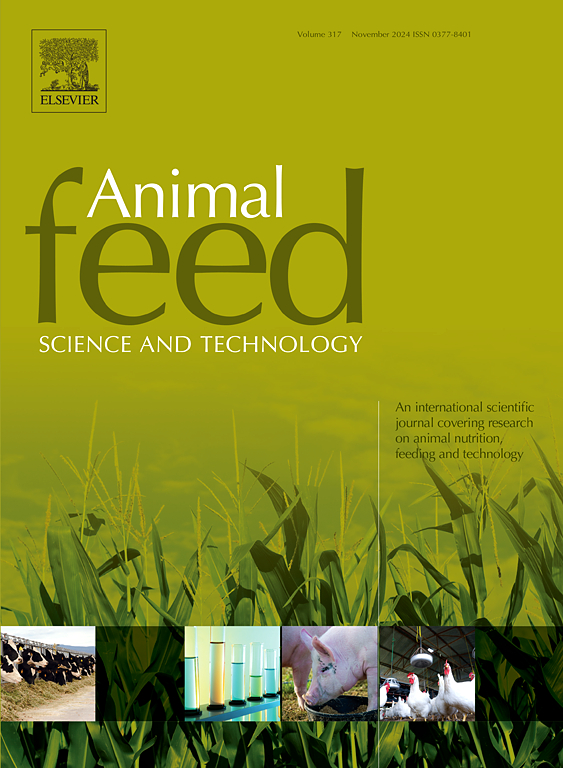Dietary non-forage fiber sources and starch levels: Effects on growth, meat fatty acid composition, and rumen bacterial community of fattening lambs
IF 2.5
2区 农林科学
Q1 AGRICULTURE, DAIRY & ANIMAL SCIENCE
引用次数: 0
Abstract
Our objective was to investigate the interactions between non-forage fiber sources (NFFS) and starch levels (SL) on growth performance, meat fatty acid composition, and ruminal bacterial community of fattening lambs. Two hundred forty healthy three-month-old Hu sheep male lambs (30.28 ± 0.324 kg of body weight) were used in a 2 × 2 factorial experimental design. The experimental factors were NFFS (beet pulp, soybean hull) and SL (HS, high starch = 28.4 %; RS, reduced starch = 16 %). The experimental treatments were as follows: (1) 15 % (as fed basis) Beet pulp in HS level (BP+HS), (2) 15 % Beet pulp in RS level (BP+RS), (3) 15 % Soybean hull in HS level (SH+HS) (4) 15 % Soybean hull in RS level (SH+RS). The trial period lasted 63 days. The final weight, average daily gain (ADG), dry matter intake (DMI), and the proportion of rumen isobutyrate in BP were lower (P < 0.05) than those in SH, while the proportion of butyrate and valerate in BP was higher (P < 0.05). The proportion of propionate and valerate in HS was higher (P < 0.05) than that in RS, while the proportion of acetate, isobutyrate and acetate/propionate was lower (P < 0.05). Additionally, the proportions of certain saturated fatty acids, monounsaturated fatty acids and polyunsaturated fatty acids in muscle, and ruminal bacterial composition and diversity, were independently influenced by both NFFS and SL. In summary, the absence of interactions between dietary NFFS and SL on the majority of measured variables indicates that the effects of NFFS and starch are independent or interactive.
饲粮非饲料纤维来源和淀粉水平对育肥羔羊生长、肉脂肪酸组成和瘤胃细菌群落的影响
本试验旨在研究非饲料纤维源(NFFS)和淀粉水平(SL)对育肥羔羊生长性能、肉脂肪酸组成和瘤胃细菌群落的影响。选用体重30.28 ± 0.324 kg的健康3月龄湖羊公羊羔240只,采用2 × 2因子试验设计。试验因子为NFFS(甜菜浆,大豆壳)和SL (HS,高淀粉= 28.4 %);RS,还原淀粉= 16 %)。试验处理为:(1)15 % HS水平的甜菜粕(BP+HS),(2) 15 % RS水平的甜菜粕(BP+RS),(3) 15 % HS水平的大豆壳(SH+HS)(4) 15 % RS水平的大豆壳(SH+RS)。试验期63 d。末重、平均日增重(ADG)、干物质采食量(DMI)和瘤胃异丁酸盐占BP的比例低于SH组(P <; 0.05),而丁酸盐和戊酸盐占BP的比例高于SH组(P <; 0.05)。HS中丙酸盐和戊酸盐的比例高于RS (P <; 0.05),而乙酸盐、异丁酸盐和乙酸/丙酸盐的比例低于RS (P <; 0.05)。此外,肌肉中某些饱和脂肪酸、单不饱和脂肪酸和多不饱和脂肪酸的比例以及瘤胃细菌的组成和多样性均受到NFFS和SL的独立影响。综上所述,饲粮NFFS和SL对大多数测量变量没有相互作用,表明NFFS和淀粉的影响是独立的或相互作用的。
本文章由计算机程序翻译,如有差异,请以英文原文为准。
求助全文
约1分钟内获得全文
求助全文
来源期刊

Animal Feed Science and Technology
农林科学-奶制品与动物科学
CiteScore
6.00
自引率
6.20%
发文量
266
审稿时长
3 months
期刊介绍:
Animal Feed Science and Technology is a unique journal publishing scientific papers of international interest focusing on animal feeds and their feeding.
Papers describing research on feed for ruminants and non-ruminants, including poultry, horses, companion animals and aquatic animals, are welcome.
The journal covers the following areas:
Nutritive value of feeds (e.g., assessment, improvement)
Methods of conserving and processing feeds that affect their nutritional value
Agronomic and climatic factors influencing the nutritive value of feeds
Utilization of feeds and the improvement of such
Metabolic, production, reproduction and health responses, as well as potential environmental impacts, of diet inputs and feed technologies (e.g., feeds, feed additives, feed components, mycotoxins)
Mathematical models relating directly to animal-feed interactions
Analytical and experimental methods for feed evaluation
Environmental impacts of feed technologies in animal production.
 求助内容:
求助内容: 应助结果提醒方式:
应助结果提醒方式:


